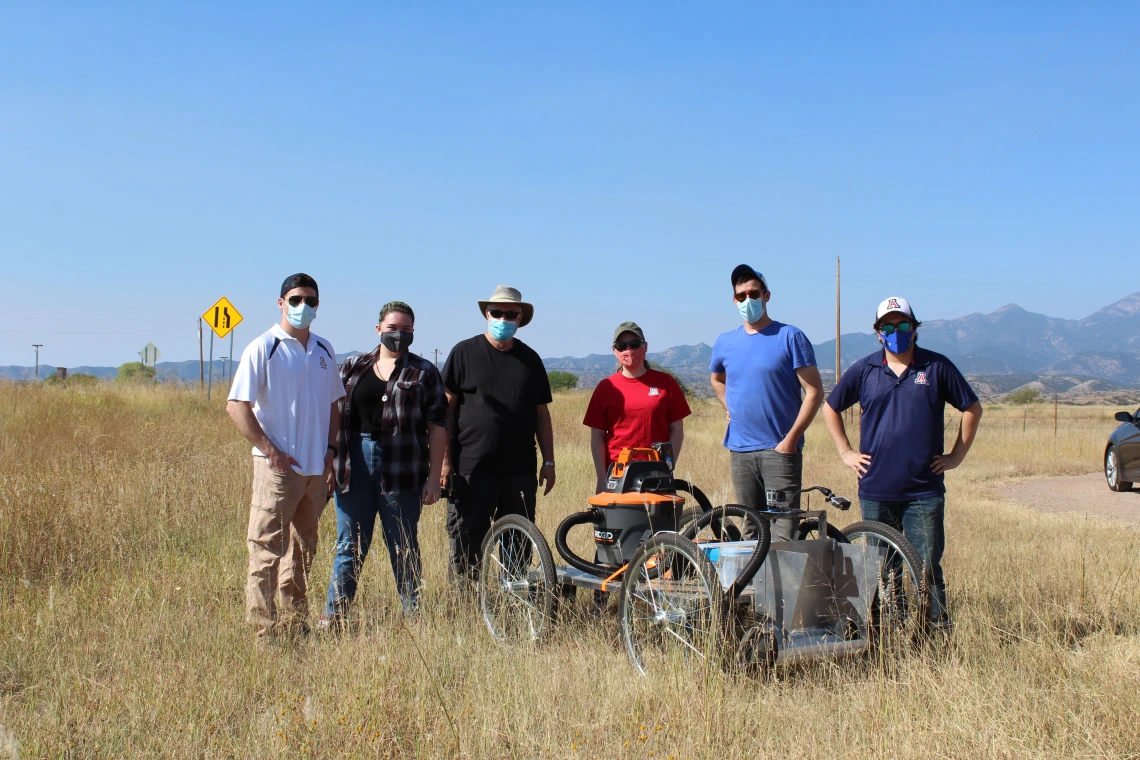Fast-Tracking a Grasshopper Catcher

Jake Vartanian, Elena Ball, Professor Goggy Davidowitz, Cecilia Stoesser, J.R. Dodge and Anthony Hazou. Team members Zepeng Cai and Emma Huffman not pictured.
Project Title: Grasshopper Harvester Phase III
Team 21022 Members:
Elena Ruth Ball, biosystems engineering
Zepeng Cai, electrical and computer engineering
J.R. Dodge, mechanical drafting at Pima Community College
Anthony Hazou, electrical and computer engineering
Emma Rose Huffman, biosystems engineering
Cecilia Lauren Stoesser, engineering management
Jake William Vartanian, mechanical engineering
Sponsor: UA Department of Entomology
Engineering seniors are adept at designing, building and developing creative solutions. Team 21022 is also particularly good at catching grasshoppers.
This is the third year a team of seniors has taken on a project sponsored by entomology professor Goggy Davidowitz: a device that can capture grasshoppers from agricultural fields. For one, grasshoppers are pests, and organic farmers who limit their use of pesticides could benefit from a way to remove them from crops. Ultimately, Davidowitz also envisions a future in which grasshoppers and other insects become a major source of protein for humans.
This year’s team has several advantages. Not only are they building on the progress made by the two previous teams, but they’re also using the Agile Method, a technique first introduced to the Interdisciplinary Capstone program in 2019, which is increasingly common in software companies. In Agile process, engineers use customer input to focus on a specific element of a project that will bring the most value to the customer, and then design, validate and implement that piece before moving onto the next one. The team is also part of a recently developed initiative in which Pima Community College students participate on capstone teams.
“It was right up my alley,” said PCC student J.R. Dodge, who is studying mechanical drafting. “I have a decent understanding of auto mechanics, so I was like, ‘Oh, we’re building a little car to vacuum up grasshoppers.’”
The team met with Davidowitz on Sept. 3, a few days after they were all assigned to the project. He asked if they could have a working version of the device ready by the first week of October. He was hoping to be able to test the device while there were still grasshoppers out, because they aren’t in season during the winter. The team worked quickly and managed to find a patch of grass on the side of a highway with some wingless grasshoppers to test how well the capture mechanism worked.
“It was definitely a scramble to start with,” said mechanical engineering student Jake Vartanian. “We had two weeks to do CAD drawings and a design of our cart, and the following two weeks were in the shop. J.R. was in the shop 40 hours a week, and I was there about half of that.”
While they still have improvements to make to the device – including fine-tuning the turning mechanism – they currently have a working version of what their client asked for, known in Agile as the minimum viable product.
They say that the challenges posed by the COVID-19 pandemic haven’t affected their progress too severely. Electrical and computer engineering major Anthony Hazou is able to do much of his circuit work from home, several team members at a time can work in the shop together with masks and social distancing, and the device testing was done outside – also with masks and distancing.
“I’ve never really done something like this that has real-world application on this scale,” said biosystems engineering student Emma Huffman. “We’re really building something and trying to market it. It definitely feels more meaningful than anything else I’ve done in school.”

